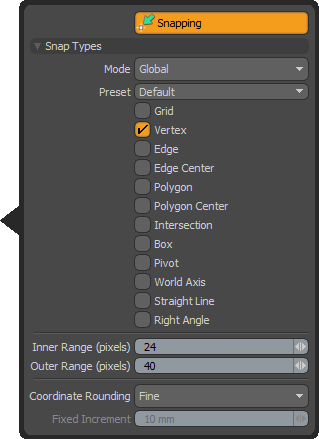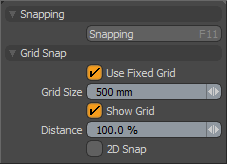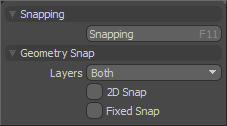
Sometimes when positioning elements relative to each other a high degree of precision is required, but zooming in to microscopic levels isn't accurate enough, nor is entering numeric values efficient (and neither is very user-friendly). In these cases it is appropriate to use Snapping, a function that allows users to produce a highly accurate result, while maintaining a standard, interactive workflow. Snapping in MODO is the action between two elements, one moving and the other static, where the moving element will snap to the static elements position, jumping away from the cursor when positioned within a user defined range. This makes it easy to very accurately create and align elements in relation to one another, or in relation to 3D space.
Usage
Snapping is disabled by default, but it can be easily enabled be LMB+clicking the 'Snapping' button over the interface window (highlighted above). Snapping is active when the button is highlighted orange. Users can also activate snapping with a shortcut by tapping the 'X' button on the keyboard. To temporarily enable snapping during an operation, users can press and hold the 'X' key to snap the element, and then release the key to disable. Keep in mind that the 'X' key is a toggle so it can also be used to disable Snapping with a tap or temporarily disable Snapping when held down during an action.
When snapping is enabled, it will conform to the settings of the Snapping options panel where users can enable and disable specific scene features there that will trigger the Snapping action. The panel can be accessed one of two ways. In the Tool Properties viewport there is a persistent 'Snapping' button, LMB+click it to open the panel, or simply press the 'F11' keyboard shortcut to open a viewport popover under the mouse pointer; LMB+click away from the panel to dismiss it. The various options of the Snapping panel are detailed further below.
To aid the snapping workflow a number of pre-highlighting cues are employed for the cursor and target, when the cursor is close to the snapping range (the defined 'Outer Range' control) the possible snapping targets will highlight making it easier to predict the possible snapping locations or as feedback that snapping has occurred.
Snapping Workflow
One of the most important things to keep in mind regarding snapping in MODO is that the Snapping function snaps a tools handle, the widget (or gizmo if you prefer) that appears in the viewport when applying an action. The position (and orientation) of the active tool handle is controlled by the Action Center, so understanding these settings are important. Users will want to make sure to have an appropriate 'Action Center' preset defined for the desired result.
By default MODO has no defined Action Center (See the 'Action Center' page of the documentation for more information). What happens in this state is when the user clicks in the viewport, MODO will move the active tool handle to the intersection point of the Work Plane and the mouse cursors click. If the user tried to click over a specific vertex, they might be exact (unlikely), they might be close, or they might not be close at all. Then, when moving the elements and snapping, the result would be very inaccurate and it would appear as if snapping failed. It actually didn't, It just wasn't told the correct thing to do.
To properly snap a single vertex to another single vertex, users would first need to enable the snapping feature option for 'Vertex' and then set the 'Action Center' to 'Selection Center Auto Axis'. Then selecting a single vertex, invoke the 'Move' tool (W) and then moving the vertex, press and hold down 'X', to enable snapping temporarily. The single vertex will then properly snap to whatever new vertex the mouse hovers over. Releasing the mouse button and then the 'X' key will set the element at the snapped position. Users will not need to set all these options each time using Snapping, as it will remember what setting was applied the last time it was used. It is also possible to define Snapping presets that users can easily apply within the Snapping Options panel, or by creating custom snapping controls specific to a single tool with the power of the Tool Pipe.
Snapping Options
 The 'Snapping Options' menu allow users to control what scene features are snapped and when. Users can select any number of controls simultaneously as well as the 'Mode' that determines when the snapping will occur.
The 'Snapping Options' menu allow users to control what scene features are snapped and when. Users can select any number of controls simultaneously as well as the 'Mode' that determines when the snapping will occur.
Snapping: This button toggles the Snapping functionality enabled or disabled (same as the button above the modeling viewport).
Snap Types--
Mode: The 'Mode' options are used to define different snapping features (listed below) depending on the current selection mode, with each Mode retaining its own individual definition. To select, LMB+click over the menu to open the popup form and LMB+click again over the desired selection when highlighted orange.
The 'Global' mode determines the Snapping features that will work globally, regardless of selection mode. The 'Component' Mode determines additional Snapping functionality that will apply concurrently to the Global values when working with 'Vertices', 'Edges' and 'Polygons'. The 'Items' Mode determines additional Snapping functionality that will apply concurrently to the Global values when working with 'Items', 'Centers' and 'Pivots'.
Example-- One could set a Global mode snap option for 'Box' and then a Component mode option for 'Vertex' and 'Edge' and finally an Items mode option for 'Pivot'. Then when editing a vertex (a component), snap would adhere to the Global setting of 'Box', plus the component settings for 'Vertex' and 'Edge' but ignore the Items settings of 'Pivot'. Feel free to mix them up as you see fit.
Presets: Combinations of Snapping Features can be stored as 'Presets' making it easy to switch between often used combinations. To create a 'Preset', simply select the 'Create Preset' option from the popup form. This opens a dialog box where you type in a unique name for the Preset. Press 'OK' to create the preset and it will automatically be selected in the 'Preset' list. While the named preset is selected, simply select any number of features in any 'Mode' and they will be saved into that Preset automatically when the Snapping options panel is closed. Switching between different Presets can be done by simply selecting the named Preset within the 'Preset' popup form. To remove a Preset, select 'Remove Preset and then choose the named preset from the popup dialog box and press 'OK'.
Snapping Features: The following options all pertain to specific scene features that can be toggled enabled/disabled. Multiple features can be selected at once and are stored independently for each 'Mode'.
Grid- When selected users will be able to define a fixed grid amount for snapping.
Vertex- When selected will snap to any individual Vertex position.
Edge- When selected will snap to any position along a polygons Edge.
Edge Center- When selected will snap the center of the target Edge.
Polygon- When selected will snap to any position of a Polygons surface.
Polygon Center- When selected will snap to the center* of the target polygon (*average position of all associated vertices)
Intersection- When selected will snap to the point of intersection between an Edge and a Polygon.
Box- When selected will snap to the cardinal positions of the target items overall Bounding Box.
Pivot- When selected will snap to the Pivot location of the target Item.
World Axis- When selected tools will align to XYZ axes. Only the 'Pen' and 'Mirror' tools support this snap type.
Straight Line- When selected will snap to a straight line. Only the 'Pen' and any Pen generator type tools support this snap type.
Right Angle- When selected will snap to right (90°) angles. Only the 'Pen' and any Pen generator type tools support this snap type.
Inner Range: Determines the range, in screen pixels, where a selected element will snap to the target element.
Outer Range: Determines the range, in screen pixels, where pre-highlighting will occur. When snap element and target element are within this proximity range, the target element will highlight.
Coordinate Rounding: This option controls how mouse input is converted, via the Work Plane, into 3D coordinates.
None-- This means that no coordinate rounding is done. Every mouse move gives unclamped coordinates (typically with lots of decimals). This option is basically the raw 2D -> 3D transform. Useful for working freehand.
Normal-- This option attempts to give clean, round coordinates based on the users view transform; so as the mouse moves, users can see values that are nice in your current unit system display in the information tab. The step size will get smaller or larger as the user zooms in or out. Users may need to move the mouse cursor 2-3 pixels to see values update.
Fine-- This option is similar to 'Normal' but optimizes for closer to one step of coordinate rounding from one pixel of mouse movement. Gives the user finer grained input, but can be difficult to hit exact values.
Fixed-- This option uses the 'Fixed Increment' preference to put a lower limit on both coordinate rounding and the grid. If the user sets the fixed increment to 10mm that means the grid will never get finer than 10mm, and all input will be rounded to the nearest 10mm even at high zoom. When zoomed out, however, the grid will show larger values but the step size will always be a multiple of the fixed increment.
Forced Fixed-- This option is similar to 'Fixed', but forces the size of the grid and the input step to match the increment exactly no matter the zoom level.
Fixed Increment: When the Coordinate Rounding is set to either 'Fixed' options, this value determines the Fixed coordinate rounding grid.
Special Snapping Options
When certain snapping features are selected, additional options appear in both the Snapping options panel and the Tool Properties panel for added convenience. These allow users to define specific controls related the the selected Snapping feature.
Grid Snap--
Snapping of selected element is fixed to a user defined grid. This setting can be helpful in keeping values to whole numbers (eliminating numbers with decimals) and can make the construction of geometry that conforms to a grid far easier and more precise to create such as a blueprint or floor plan.
 Use Fixed Grid: When this toggle is enabled, users can define a fixed grid with the 'Grid Size' setting, which sets the snapping interval. When disabled, the grid snapping defaults to the dynamic grid displayed in the 3D viewports.
Use Fixed Grid: When this toggle is enabled, users can define a fixed grid with the 'Grid Size' setting, which sets the snapping interval. When disabled, the grid snapping defaults to the dynamic grid displayed in the 3D viewports.
Grid Size: When the 'Use Fixed Grid' option is enabled, this value input filed defines the interval for the fixed grid, originating at the 0,0,0 world origin position.
Show Grid: The 'Show Grid' toggle displays the grid as a light magenta overlay in the viewport, which dynamically updates similar to the Work Plane, in the center of the viewport as a visual reference to the 'Grid Size' setting.
Distance: This option defines the snapping range, the distance when MODO will snap to the closest grid position. When set at the default 100%, MODO will always keep values fixed to the grid, reducing this value would require the cursor to be closer to the grid positions before snapping occurs.
2D Snap: The 2D snap function relates to the orthographic viewports (top, front, side etc.) that allow snapping on fixed planes parallel to the viewport window, this allows users to move points so they snap into position in the viewport, but they don't necessarily snap into a co-located position in 3D space.
Geometry Snap--
Snapping to specific component elements. These snapping options allow users to very precisely position geometric elements in relation to one another.
 Layers: Instructs MODO as to which layers it should consider for snapping, 'Background' only takes into account layers that are visible but not selected, 'Active' only takes into account selected visible layers (also known as foreground layers) and 'Both' which takes into account all visible geometry in the Item List.
Layers: Instructs MODO as to which layers it should consider for snapping, 'Background' only takes into account layers that are visible but not selected, 'Active' only takes into account selected visible layers (also known as foreground layers) and 'Both' which takes into account all visible geometry in the Item List.
2D Snap: The 2D snap function relates to the orthographic viewports (top, front, side etc.) and allow snapping on fixed planes parallel to the viewport window, thus allows users to move points so they snap into position in the viewport, but they don't necessarily snap into a co-located position in 3D space.
Fixed Snap: This toggle, when enabled forces MODO to only position the moving element to snapping positions, normally moving elements would move, and then snap as they neared an element, but 'Fixed Snap' jumps the elements between snap-able positions.
Pivot Snap Mode--
Snaps selected element to items Pivot elements. This option can be helpful when several items need to pivot rotate from the same location.
 Snap Size: This values defines how close an element must be to snap to the pivot position. Larger values will more easily snap elements to the pivot position of an item layer.
Snap Size: This values defines how close an element must be to snap to the pivot position. Larger values will more easily snap elements to the pivot position of an item layer.


